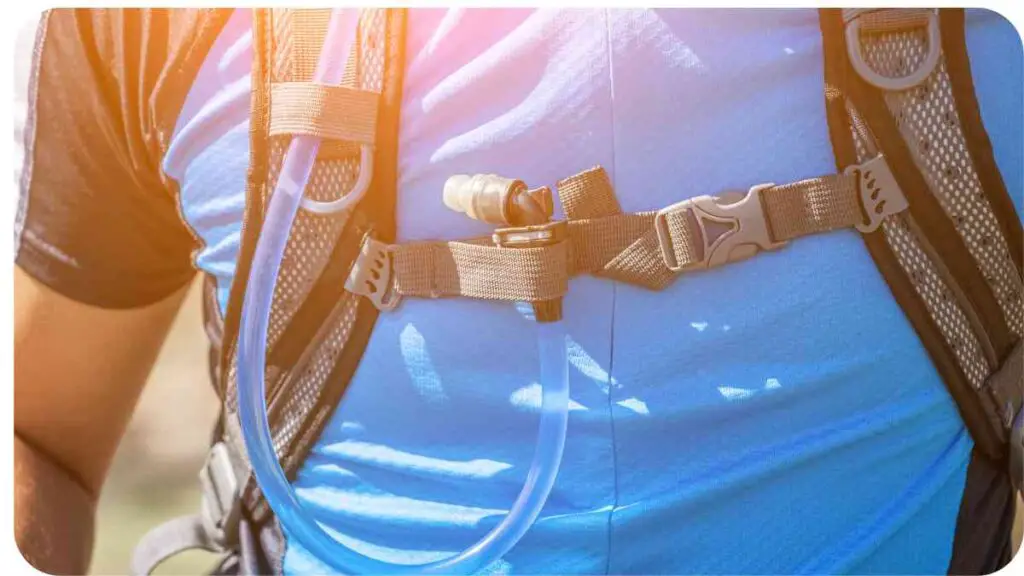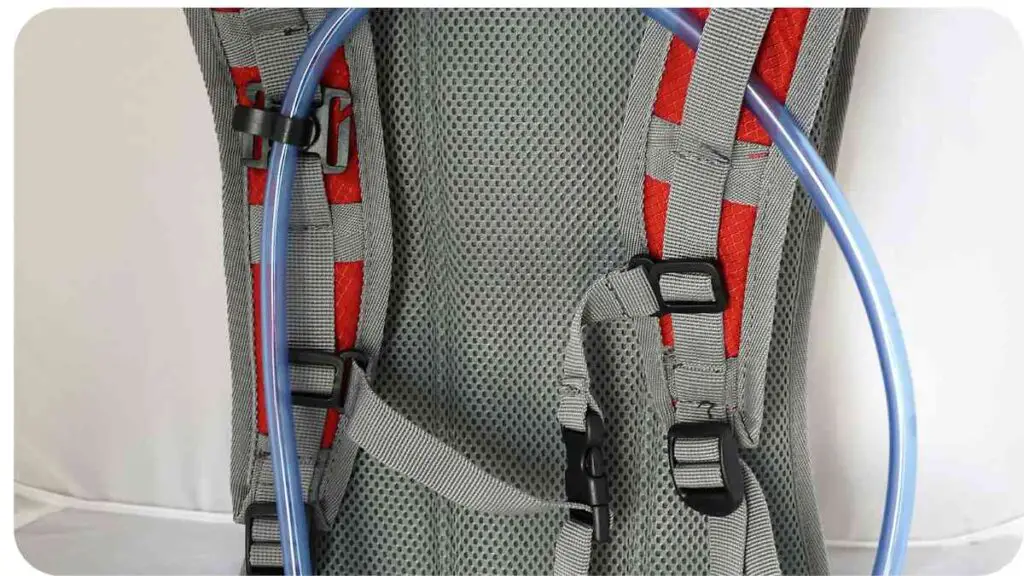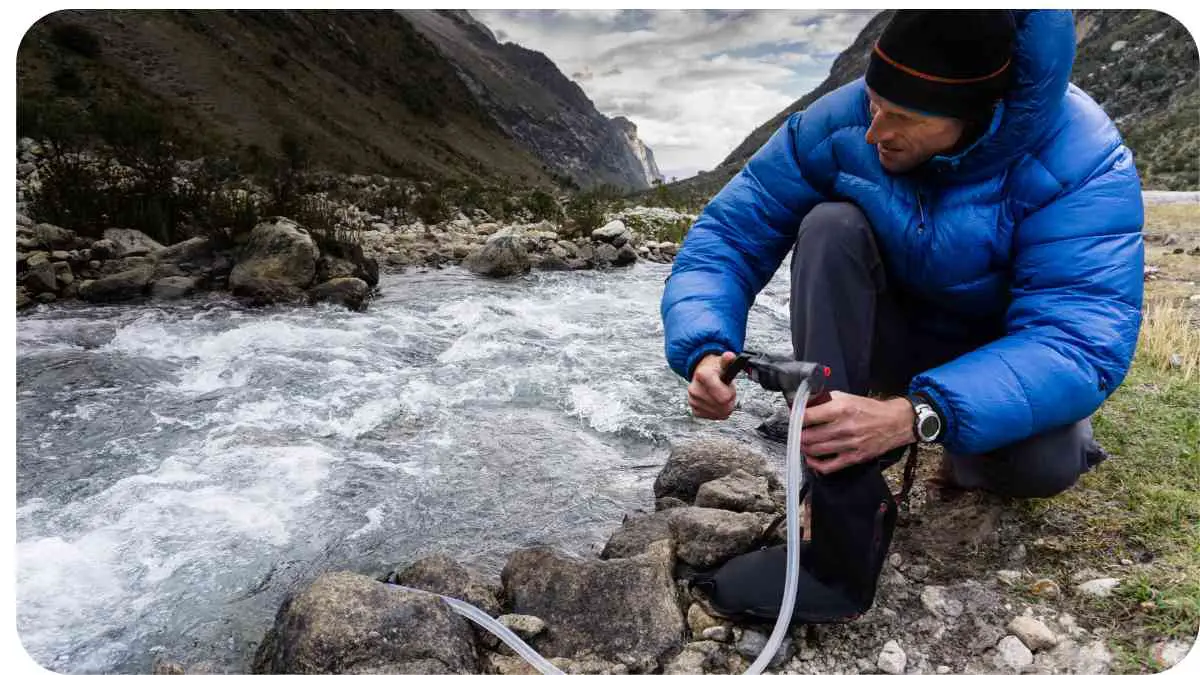Welcome, adventure seekers and outdoor enthusiasts, to a guide that’s about to change the way you enjoy your outdoor escapades. Imagine this: you’re on a thrilling hike, conquering nature’s challenges, when you suddenly notice a damp spot on your back.
Yes, it’s the dreaded leak in your trusty CamelBak hydration pack. Fret not, for I’m here to share my expertise and personal experiences in fixing these leaks and ensuring uninterrupted hydration.
| Key Takeaways |
|---|
| 1. Securely seal your CamelBak bladder to prevent leaks. |
| 2. Regularly inspect and maintain your hydration pack’s components. |
| 3. Identify the source of the leak by examining the bladder, seams, and valve. |
| 4. Use DIY techniques like re-sealing, patching holes, and valve replacement. |
| 5. Practice proper storage and cleaning to prevent future leaks. |
| 6. Invest in quality hydration packs from reputable brands. |
| 7. Replace worn-out parts promptly to avoid major leaks. |
| 8. Dedicate time to cleaning and upkeep after every adventure. |
| 9. Learn from real experiences and stories shared by other hikers. |
| 10. Troubleshoot common issues like low flow, foul taste, and leakage. |
| 11. Compare CamelBak models based on features, capacity, and best uses. |
| 12. Always ensure a leak-free CamelBak for a confident outdoor adventure. |
Understanding CamelBak Hydration Packs

Before we dive into the nitty-gritty of leak resolutions, let’s briefly explore what makes CamelBak hydration packs the go-to choice for adventurers worldwide. CamelBak packs are renowned for their ergonomic design, durable materials, and, most importantly, their leak-proof reputation. However, even the most reliable gear can face issues over time.
“When adjusting your backpack for the perfect fit, comfort is key. Proper adjustments not only prevent discomfort but also enhance your outdoor experience. Learn expert techniques to optimize your backpack for any adventure.”
Common Causes of Leaks
Improper Sealing
One of the primary culprits behind hydration pack leaks is improper sealing. You might be in a hurry to quench your thirst and hastily seal the bladder, unintentionally leaving a gap for water to escape. Remember, a secure seal is key to leak prevention.
| Issue | Cause | Solution |
| Improper Sealing | Rushing to seal the bladder | Double-check the seal before use |
Wear and Tear
Adventure takes a toll on gear, and hydration packs are no exception. Straps, seams, and zippers can wear down with time, potentially leading to leaks. Regular inspections are crucial.
| Issue | Cause | Solution |
| Wear and Tear | Aging components | Replace worn-out parts promptly |
| Valve Issues | Damaged valve mechanism | Refer to the valve replacement section |
Maintenance Neglect
Just like any equipment, neglecting maintenance can lead to issues. Hydration packs gather dirt, mold, and residue that can compromise their integrity. Regular cleaning can prevent leaks.
“Unlock the full potential of your Yeti cooler with these efficiency tips. Keeping your supplies cool is crucial during camping trips. Discover insider tricks to make your cooler work smarter and keep your items refreshingly chilled.”
| Issue | Cause | Solution |
| Maintenance Neglect | Lack of cleaning and upkeep | Establish a cleaning routine |
Identifying the Source of the Leak

When you notice a leak, it’s essential to pinpoint its origin before attempting repairs. Here’s how:
Inspecting the Bladder
Start by filling the bladder and gently squeezing it. Watch for any moisture seeping through the material. If you spot dampness, the bladder might be compromised.
| Issue | Cause | Solution |
| Bladder Leak | Damaged bladder material | Consider bladder replacement |
Checking the Seams and Zippers
Carefully examine the seams and zippers for any visible damage. A small tear or loose seam can lead to leaks during use.
| Issue | Cause | Solution |
| Seam or Zipper Leak | Torn seams or damaged zippers | Apply appropriate repairs or patches |
Evaluating the Valve
Sometimes, leaks can occur through the valve. Ensure that it’s properly closed and not damaged.
| Issue | Cause | Solution |
| Valve Leak | Faulty valve mechanism | Replace the valve as needed |
DIY Leak Resolution
Now that you’ve identified the source of the leak, it’s time to roll up your sleeves and tackle the issue head-on. Here are some do-it-yourself techniques to put that hydration pack back in action:
“Don’t let stove issues spoil your outdoor cooking. Swift solutions for common MSR stove problems ensure uninterrupted meal preparation. Explore quick fixes and expert advice, ensuring your camping cuisine is always on point.”
Re-sealing Techniques
If your leak stems from an improper seal, fear not! Empty the bladder, ensure it’s dry, and reseal it carefully. Make sure there are no folds or wrinkles in the sealing area.
| Technique | Steps | Effectiveness |
| Re-sealing | Empty, dry, and reseal the bladder properly | High if executed accurately |
Patching Small Holes
For minor bladder punctures, patch kits can be a lifesaver. Clean the area around the hole, apply the patch according to the instructions, and let it set.
| Technique | Steps | Effectiveness |
| Patching Holes | Clean, apply patch, let set | Effective for small punctures |
Valve Replacement
Should your valve be the culprit, replacing it might be necessary. Refer to your CamelBak’s manual or online resources for guidance.
| Technique | Steps | Effectiveness |
| Valve Replacement | Remove old valve, install new one | Effective for valve-related leaks |
Preventing Future Leaks
An ounce of prevention is worth a gallon of repair. Here’s how to ensure your hydration pack stays leak-free on all your journeys:
“A good night’s sleep is essential for camping. Don’t let sleeping pad troubles disrupt your rest. Learn valuable tips and tricks to address common issues, ensuring you wake up refreshed and ready to embrace the great outdoors.”
Regular Maintenance
Make it a habit to inspect and clean your pack after every adventure. Ensure seams are intact, zippers are functional, and the bladder is clean.
Proper Storage
Store your hydration pack in a cool, dry place. Avoid leaving it in direct sunlight or extreme temperatures, as these can accelerate wear and tear.
Cleaning Procedures
Regular cleaning is vital to prevent mold and residue buildup. Use warm soapy water or CamelBak’s cleaning solutions and rinse thoroughly.
Expert Recommendations
Drawing from my years of experience, here are some expert tips to keep your CamelBak leak-free and ready for action:
- Invest in Quality: A high-quality hydration pack is an investment in leak-free adventures. Look for reputable brands known for durability.
- Replace Parts Timely: Don’t hesitate to replace worn-out parts. A small expense now can save you from major leaks later.
- Practice Maintenance: Dedicate a few minutes to inspect and clean your pack after each adventure. It’s a small effort that pays off.
“Proper care and maintenance extend your tent’s life. Explore expert tips from The North Face to keep your shelter in prime condition. Discover cleaning techniques and maintenance practices that safeguard your tent, ensuring it remains a reliable sanctuary during your outdoor adventures.”
Real-life Experiences
Let’s face it, we all learn from real stories. One of my memorable hiking trips took an unexpected turn when my hydration pack sprung a leak. Thankfully, a fellow hiker lent me a patch kit, and we had a good laugh over our makeshift repairs.
Troubleshooting Guide
| Issue | Probable Cause | Solution |
| Low Flow | Clogged valve or tube | Clean valve and tube thoroughly |
| Foul Taste | Residue buildup in the bladder | Clean and rinse the bladder well |
| Leakage | Damaged bladder or valve | Follow earlier repair guidelines |
Comparing CamelBak Models
| Model | Features | Capacity | Best For |
| CamelBak A | Lightweight design, minimalist style | 1.5L | Short hikes, trail runs |
| CamelBak B | Multiple pockets, extra storage options | 2.0L | Day hikes, cycling |
| CamelBak C | Insulated bladder, rugged materials | 2.5L | Long treks, extreme sports |
Final Thoughts
In the world of outdoor adventures, having a dependable hydration pack is a game-changer. By understanding the causes of leaks, identifying the source, and mastering repair techniques, you can ensure that your CamelBak remains your trusty companion on every trail. Remember, a little maintenance goes a long way in keeping leaks at bay. Now, armed with knowledge and practical tips, venture forth and conquer nature’s challenges with confidence and a leak-free CamelBak by your side.
Further Reading
For more detailed information and step-by-step guides on resolving leaks in your CamelBak hydration pack, consider checking out these resources:
- Fixing a Hole in Your CamelBak Bladder
- Learn how to patch up small holes in your CamelBak bladder using simple techniques and readily available tools.
- Dealing with a Leaking CamelBak Bladder
- Discover common causes of leaks and effective solutions to address them, ensuring a leak-free outdoor experience.
- CamelBak Reservoirs FAQ
- Get answers to frequently asked questions about CamelBak reservoirs, maintenance, and troubleshooting.
FAQs
How do I identify a leak in my CamelBak hydration pack?
To identify a leak, fill the bladder, squeeze it gently, and check for moisture seeping through the material. If you notice dampness, the bladder might be compromised.
Can I use standard patches to fix a hole in my CamelBak bladder?
Yes, standard patch kits can effectively fix small holes in your CamelBak bladder. Clean the area around the hole, apply the patch according to the instructions, and allow it to set.
What should I do if my CamelBak valve is leaking?
If your CamelBak valve is leaking, consider replacing the valve mechanism. Refer to your CamelBak’s manual or online resources for guidance on proper replacement.
How often should I clean my CamelBak hydration pack?
It’s recommended to clean your CamelBak after every adventure. Regular cleaning prevents mold and residue buildup, ensuring a clean and leak-free bladder.
Are there different CamelBak models for various activities?
Yes, CamelBak offers various models designed for different activities. For instance, models like CamelBak A are suitable for short hikes and trail runs, while models like CamelBak C with insulated bladders are great for long treks and extreme sports.

I’m Hellen James, and I am a camping enthusiast. I’ve been camping since I was a kid and have always loved it the fresh air, the beautiful scenery, and the great outdoors. In fact, it’s one of my favorite things to do in the summer!


